Appraisal of Post-Harvest Drying and Storage Operations in Africa: Perspectives on Enhancing Grain Quality
Abstract
:1. Introduction
2. Methodology
3. The Nexus between Drying and Storage: A Tale of Grain Quality
4. Grain Drying Operations in Africa
4.1. Conventional Drying Technologies
4.1.1. Open Sun Drying
4.1.2. Traditional Cribs
4.2. Improved Drying Technologies
4.2.1. Use of Solar Dryers
4.2.2. Use of Mechanical Dryers
5. Grain Storage Operations in Africa
5.1. Traditional Grain Storage Facilities
5.1.1. Open Aerial Storage
5.1.2. Open Fire Storage
5.1.3. African Gourds
5.1.4. Granaries
5.1.5. Storage Bags
5.2. Improved Grain Storage
5.2.1. Grain Treatment with Pesticides
5.2.2. Community Storage Structures
5.2.3. Use of Warehouses
5.2.4. Bin Storage Silos
5.2.5. The Novel Hermetic Storage Technology (HST)
6. Appraisal of the Drying and Storage Operations in Africa: The State of Grain Quality
6.1. Assessment of Drying Operations
6.1.1. Traditional Drying Techniques
6.1.2. Improved Drying Techniques
6.2. Assessment of Storage Operations
6.2.1. Traditional Storage Techniques
6.2.2. Improved Storage Techniques
7. Perspectives for Improved Grain Quality in Africa: Lessons from Successful Post-Harvest Drying and Storage Models in Africa
7.1. The Cob Model—Rwanda
7.2. The WFP Zero Food Loss Initiative Model—Uganda
7.3. The AflaSight Model—Rwanda
8. Conclusions
Author Contributions
Funding
Data Availability Statement
Conflicts of Interest
References
- Weinberg, Z.G.; Yan, Y.; Chen, Y.; Finkelman, S.; Ashbell, G.; Navarro, S. The effect of moisture level on high-moisture maize (Zea mays L.) under hermetic storage conditions—In vitro studies. J. Stored Prod. Res. 2008, 44, 136–144. [Google Scholar] [CrossRef]
- Jayas, D.; Singh, C. Grain quality evaluation by computer vision. In Computer Vision Technology in the Food and Beverage Industries; Sun, D.-W., Ed.; Woodhead Publishing: Cambridge, UK, 2012; pp. 400–421. [Google Scholar] [CrossRef]
- Kumar, P.; Mahato, D.K.; Kamle, M.; Mohanta, T.K.; Kang, S.G. Aflatoxins: A Global Concern for Food Safety, Human Health and Their Management. Front. Microbiol. 2016, 7, 2170. [Google Scholar] [CrossRef]
- Lebelo, K.; Malebo, N.; Mochane, M.J.; Masinde, M. Chemical contamination pathways and the food safety implications along the various stages of food production: A review. Int. J. Environ. Res. Public Health 2021, 18, 5795. [Google Scholar] [CrossRef] [PubMed]
- European Commission; Joint Research Centre; Rembold, F.; Hodges, R.; Bernard, M. APHLIS—Postharvest Cereal Losses in Sub-Saharan Africa, Their Estimation, Assessment and Reduction; Publications Office: Luxembourg, 2014. [Google Scholar]
- Hori, K.; Sun, J. Rice Grain Size and Quality. Rice 2022, 15, 33. [Google Scholar] [CrossRef]
- Ishfaq, M.; Akbar, N.; Zulfiqar, U.; Hussain, S.; Murtza, K.; Batool, Z.; Ashraf, U.; Alyemeni, M.N.; Ahmad, P. Influence of Nitrogen Management Regimes on Milling Recovery and Grain Quality of Aromatic Rice in Different Rice Production Systems. Agronomy 2020, 10, 1841. [Google Scholar] [CrossRef]
- Ba, M.N. Competiveness of Maize Value Chains for Smallholders in West Africa: Case of Benin, Ghana and Cote D’Ivoire. Agric. Sci. 2017, 8, 1372–1401. [Google Scholar] [CrossRef]
- Akoko, P.O.; Degroote, H.; Gathungu, E.; Ricker-Gilbert, J. Technical and economic analysis of small-scale maize dryers in Kenya. In Proceedings of the International Conference of Agricultural Economists, Virtual, 17–31 August 2021. [Google Scholar]
- Ekpa, O.; Palacios-Rojas, N.; Kruseman, G.; Fogliano, V.; Linnemann, A.R. Sub-Saharan African Maize-Based Foods—Processing Practices, Challenges and Opportunities. Food Rev. Int. 2019, 35, 609–639. [Google Scholar] [CrossRef]
- Okori, F.; Cherotich, S.; Baidhe, E.; Komakech, A.J.; Banadda, N. Grain Hermetic Storage and Post-Harvest Loss Reduction in Sub-Saharan Africa: Effects on Grain Damage, Weight Loss, Germination, Insect Infestation, and Mold and Mycotoxin Contamination. J. Biosyst. Eng. 2022, 47, 48–68. [Google Scholar] [CrossRef]
- Raheem, D.; Dayoub, M.; Birech, R.; Nakiyemba, A. The Contribution of Cereal Grains to Food Security and Sustainability in Africa: Potential Application of UAV in Ghana, Nigeria, Uganda, and Namibia. Urban Sci. 2021, 5, 8. [Google Scholar] [CrossRef]
- Nukenine, E.N. Stored product protection in Africa: Past, present and future. In Proceedings of the International Working Conference on Stored Product Protection, Estoril, Portugal, 27 June–2 July 2010. [Google Scholar]
- Ayanlade, A.; Radeny, M. COVID-19 and food security in Sub-Saharan Africa: Implications of lockdown during agricultural planting seasons. NPJ Sci. Food 2020, 4, 13. [Google Scholar] [CrossRef]
- Tadesse, W.; Bishaw, Z.; Assefa, S. Wheat production and breeding in Sub-Saharan Africa. Int. J. Clim. Change Strateg. Manag. 2019, 11, 696–715. [Google Scholar] [CrossRef]
- Birachi, E.A.; Sperling, L.; Kadege, E.; Mdachi, M.; Upendo, T.; Radegunda, K.; Mutua, M.; Mbiu, J.; Raya, N.; Ndunguru, A.; et al. Analysis of the Yellow Bean Corridor in Tanzania: A Feed the Future Global Supporting Seed Systems for Development Activity (S34D) Report; 2020. Available online: https://pdf.usaid.gov/pdf_docs/PA00XS8V.pdf (accessed on 16 March 2024).
- Horn, L.N.; Shimelis, H. Production constraints and breeding approaches for cowpea improvement for drought prone agro-ecologies in Sub-Saharan Africa. Ann. Agric. Sci. 2020, 65, 83–91. [Google Scholar] [CrossRef]
- Manandhar, A.; Milindi, P.; Shah, A. An Overview of the Post-Harvest Grain Storage Practices of Smallholder Farmers in Developing Countries. Agriculture 2018, 8, 57. [Google Scholar] [CrossRef]
- Horn, L.N.; Nghituwamata, S.N.; Isabella, U. Cowpea Production Challenges and Contribution to Livelihood in Sub-Saharan Region. Agric. Sci. 2022, 13, 25–32. [Google Scholar] [CrossRef]
- Baoua, I.; Rabé, M.M.; Murdock, L.L.; Baributsa, D. Cowpea production constraints on smallholders’ farms in Maradi and Zinder regions, Niger. Crop Prot. 2021, 142, 105533. [Google Scholar] [CrossRef]
- Bjornlund, V.; Bjornlund, H.; van Rooyen, A. Why food insecurity persists in sub-Saharan Africa: A review of existing evidence. Food Sec. 2022, 14, 845–864. [Google Scholar] [CrossRef]
- Owolade, A.J.-J.; Abdullateef, R.O.; Adesola, R.O.; Olaloye, E.D. Malnutrition: An underlying health condition faced in sub Saharan Africa: Challenges and recommendations. Ann. Med. Surg. 2022, 82, 104769. [Google Scholar] [CrossRef]
- Bjornlund, V.; Bjornlund, H.; Van Rooyen, A.F. Why agricultural production in sub-Saharan Africa remains low compared to the rest of the world—A historical perspective. Int. J. Water Resour. Dev. 2020, 36, S20–S53. [Google Scholar] [CrossRef]
- Mutungi, C.; Abass, A.; Fischer, G.; Kotu, B. Improved technologies for reducing post-harvest losses. In Sustainable Agricultural Intensification: A Handbook for Practitioners in East and Southern Africa; Bekunda, M., Hoeschle-Zeledon, I., Odhong, J., Eds.; CABI International: Wallingford, UK, 2022; pp. 91–105. [Google Scholar]
- Sugri, I.; Abubakari, M.; Owusu, R.K.; Bidzakin, J.K. Postharvest losses and mitigating technologies: Evidence from Upper East Region of Ghana. Sustain. Futures 2021, 3, 100048. [Google Scholar] [CrossRef]
- Affognon, H.; Mutungi, C.; Sanginga, P.; Borgemeister, C. Unpacking Postharvest Losses in Sub-Saharan Africa: A Meta-Analysis. World Dev. 2015, 66, 49–68. [Google Scholar] [CrossRef]
- Anthony, T.; Makombe, G.; Kele, T. An Analysis of the Characteristics of Maize Storage Types Used by Smallholder Producers in Developing Countries: A Case of Uganda. Am. J. Ind. Bus. Manag. 2019, 9, 1524–1555. [Google Scholar] [CrossRef]
- Bezabih, G.; Satheesh, N.; Workneh Fanta, S.; Wale, M.; Atlabachew, M.; Wan, C. Reducing Postharvest Loss of Stored Grains Using Plant-Based Biopesticides: A Review of Past Research Efforts. Adv. Agric. 2022, 2022, 6946916. [Google Scholar] [CrossRef]
- Kumar, D.; Kalita, P. Reducing Postharvest Losses during Storage of Grain Crops to Strengthen Food Security in Developing Countries. Foods 2017, 6, 8. [Google Scholar] [CrossRef] [PubMed]
- APHLIS. Dry Weight Loss: All Countries—All Crops—2022; APHLIS, 2024; Available online: https://www.aphlis.net/en/data/tables/dry-weight-losses/XAF/all-crops/2022?metric=prc (accessed on 8 August 2024).
- Tibagonzeka, J.E.; Akumu, G.; Kiyimba, F.; Atukwase, A.; Wambete, J.; Bbemba, J.; Muyonga, J.H. Post-harvest handling practices and losses for legumes and starchy staples in Uganda. Agric. Sci. 2018, 9, 141–156. [Google Scholar] [CrossRef]
- Daba, H.G.; Delele, M.A.; Fanta, S.W.; Satheesh, N. The extent of groundnut post-harvest loss in Africa and its implications for food and nutrition security. J. Agric. Food Res. 2023, 14, 100826. [Google Scholar] [CrossRef]
- Oni, E.O.; Komolafe, C.A.; Badmos, A.O.; Kareem, S.O.; Waheed, M.A.; Oluwafemi, F. Reduction of aflatoxin in freshly harvested maize using solar dryers. J. Sci. Food Agric. 2022, 102, 4791–4801. [Google Scholar] [CrossRef]
- Manu, N.; Osekre, E.A.; Opit, G.P.; Campbell, J.F.; Arthur, F.H.; Mbata, G.; Armstrong, P.R.; Danso, J.K. Population dynamics of stored maize insect pests in warehouses in two districts of Ghana. J. Stored Prod. Res. 2018, 76, 102–110. [Google Scholar] [CrossRef]
- Nsafoah, A. Centralized Grain Storage in Ghana: A Feasibility Analysis; Oklahoma State University: Stillwater, OK, USA, 2012. [Google Scholar]
- Adeola, E.H. Post-Harvest Management Practices among Rice Farmers in Imo State Nigeria. Eur. J. Biol. Biotechnol. 2020, 1, 1–6. [Google Scholar] [CrossRef]
- Opoku, B.; Osekre, E.A.; Opit, G.; Bosomtwe, A.; Bingham, G.V. Evaluation of Hermetic Storage Bags for the Preservation of Yellow Maize in Poultry Farms in Dormaa Ahenkro, Ghana. Insects 2023, 14, 141. [Google Scholar] [CrossRef]
- Müller, A.; Nunes, M.T.; Maldaner, V.; Coradi, P.C.; Moraes, R.S.d.; Martens, S.; Leal, A.F.; Pereira, V.F.; Marin, C.K. Rice Drying, Storage and Processing: Effects of Post-Harvest Operations on Grain Quality. Rice Sci. 2022, 29, 16–30. [Google Scholar] [CrossRef]
- Nwaigwe, K.N. An Overview of Cereal Grain Storage Techniques and Prospects in Africa. Int. J. Bioeng. Biotechnol. 2019, 4, 19–25. [Google Scholar]
- Stathers, T.; Holcroft, D.; Kitinoja, L.; Mvumi, B.M.; English, A.; Omotilewa, O.; Kocher, M.; Ault, J.; Torero, M. A scoping review of interventions for crop postharvest loss reduction in sub-Saharan Africa and South Asia. Nat. Sustain. 2020, 3, 821–835. [Google Scholar] [CrossRef]
- Hengsdijk, H.; de Boer, W.J. Post-harvest management and post-harvest losses of cereals in Ethiopia. Food Secur. 2017, 9, 945–958. [Google Scholar] [CrossRef]
- Gorjian, S.; Hosseingholilou, B.; Jathar, L.D.; Samadi, H.; Samanta, S.; Sagade, A.A.; Kant, K.; Sathyamurthy, R. Recent Advancements in Technical Design and Thermal Performance Enhancement of Solar Greenhouse Dryers. Sustainability 2021, 13, 7025. [Google Scholar] [CrossRef]
- Udomkun, P.; Romuli, S.; Schock, S.; Mahayothee, B.; Sartas, M.; Wossen, T.; Njukwe, E.; Vanlauwe, B.; Muller, J. Review of solar dryers for agricultural products in Asia and Africa: An innovation landscape approach. J. Environ. Manag. 2020, 268, 110730. [Google Scholar] [CrossRef]
- Purohit, P.; Kumar, A.; Kandpal, T.C. Solar drying vs. open sun drying: A framework for financial evaluation. Sol. Energy 2006, 80, 1568–1579. [Google Scholar] [CrossRef]
- Thamaga-Chitja, J.M.; Hendriks, S.L.; Ortmann, G.F.; Green, M. Impact of maize storage on rural household food security in Northern Kwazulu-Natal. J. Fam. Ecol. Consum. Sci. 2004, 32, 8–15. [Google Scholar] [CrossRef]
- Mobolade, A.J.; Bunindro, N.; Sahoo, D.; Rajashekar, Y. Traditional methods of food grains preservation and storage in Nigeria and India. Ann. Agric. Sci. 2019, 64, 196–205. [Google Scholar] [CrossRef]
- Adetunji, M.O. Economics of Maize Storage Techniques by Farmers in Kwara state, Nigeria. Pak. J. Soc. Sci. 2007, 4, 442–450. [Google Scholar]
- Ayeni, K.I.; Atanda, O.O.; Krska, R.; Ezekiel, C.N. Present status and future perspectives of grain drying and storage practices as a means to reduce mycotoxin exposure in Nigeria. Food Cont. 2021, 126, 108074. [Google Scholar] [CrossRef]
- Ziegler, V.; Paraginski, R.T.; Ferreira, C.D. Grain storage systems and effects of moisture, temperature and time on grain quality—A review. J. Stored Prod. Res. 2021, 91, 101770. [Google Scholar] [CrossRef]
- Sahdev, R.K. Open Sun and Greenhouse Drying of Agricultural and Food Products: A Review. Int. J. Eng. Res. Technol. 2014, 3, 1053–1066. [Google Scholar]
- Tiwari, S.; Tiwari, G.N.; Al-Helal, I.M. Development and recent trends in greenhouse dryer: A review. Renew. Sustain. Energy Rev. 2016, 65, 1048–1064. [Google Scholar] [CrossRef]
- Coradi, P.C.; Maldaner, V.; Lutz, E.; da Silva Dai, P.V.; Teodoro, P.E. Influences of drying temperature and storage conditions for preserving the quality of maize postharvest on laboratory and field scales. Sci. Rep. 2020, 10, 22006. [Google Scholar] [CrossRef]
- Akowuah, J.O.; Maier, D.; Opit, G.; McNeill, S.; Amstrong, P.; Campabadal, C.; Ambrose, K.; Obeng-Akrofi, G. Drying Temperature Effect on Kernel Damage and Viability of Maize Dried in a Solar Biomass Hybrid Dryer. Open J. Appl. Sci. 2018, 8, 506–517. [Google Scholar] [CrossRef]
- Odjo, S.; Malumba, P.; Dossou, J.; Janas, S.; Béra, F. Influence of drying and hydrothermal treatment of corn on the denaturation of salt-soluble proteins and color parameters. J. Food Eng. 2012, 109, 561–570. [Google Scholar] [CrossRef]
- Tohidi, M.; Sadeghi, M.; Torki-Harchegani, M. Energy and quality aspects for fixed deep bed drying of paddy. Renew. Sustain. Energy Rev. 2017, 70, 519–528. [Google Scholar] [CrossRef]
- de Sousa, I.G.; Oliveira, J.; Mexia, A.; Barros, G.; Almeida, C.; Brazinha, C.; Vega, A.; Brites, C. Advances in environmentally friendly techniques and circular economy approaches for insect infestation management in stored rice grains. Foods 2023, 12, 511. [Google Scholar] [CrossRef]
- Mendoza, Q.A.; Pordesimo, L.; Neilsen, M.; Armstrong, P.; Campbell, J.; Mendoza, P.T. Application of Machine Learning for Insect Monitoring in Grain Facilities. AI 2023, 4, 348–360. [Google Scholar] [CrossRef]
- Sauer, D.B. Effects of fungal deterioration on grain: Nutritional value, toxicity, germination. Int. J. Food Microbiol. 1988, 7, 267–275. [Google Scholar] [CrossRef]
- Chulze, S.N. Strategies to reduce mycotoxin levels in maize during storage: A review. Food Addit. Contam. 2010, 27, 651–657. [Google Scholar] [CrossRef] [PubMed]
- da Silva, G.M.; Ferreira, A.G.; RogérioMorouço, C.; Maia, C.B. Experimental Analysis of Corn Drying in A Sustainable Solar Dryer. J. Adv. Res. Fluid Mech. Therm. Sci. 2020, 67, 1–12. [Google Scholar]
- Tomar, V.; Tiwari, G.N.; Norton, B. Solar dryers for tropical food preservation: Thermophysics of crops, systems and components. Sol. Energy 2017, 154, 2–13. [Google Scholar] [CrossRef]
- Othman, Y.M.; Haweel, M.A.M. Design of a solar dryer for Corn. IOSR J. Mech. Civil Eng. 2021, 18, 1–9. [Google Scholar] [CrossRef]
- De Groote, H.; Githinji, P.G.; Munya, B.G.; Ricker-Gilbert, J.E. Economics of open-air sun drying in the maize value chain of Kenya. J. Agric. Food Res. 2021, 5, 100185. [Google Scholar] [CrossRef]
- Mohammed, S.; Edna, M.; Siraj, K. The effect of traditional and improved solar drying methods on the sensory quality and nutritional composition of fruits: A case of mangoes and pineapples. Heliyon 2020, 6, e04163. [Google Scholar] [CrossRef]
- Naing, T.T.; Soe, C.T. Comparative analysis of the performance of cabinet solar dryer and open sun drying for Banana slices. IOP Conf. Ser. Mater. Sci. Eng. 2021, 1127, 012015. [Google Scholar] [CrossRef]
- Falayi, F.R.; Benjamin, O. Development of a Solar Aided Crib for Drying and Storage of Maize Cobs. FUOYE J. Eng. Technol. 2019, 4, 62–66. [Google Scholar] [CrossRef]
- Hii, C.L.; Abdul Rahman, R.; Jinap, S.; Che Man, Y.B. Quality of cocoa beans dried using a direct solar dryer at different loadings. J. Sci. Food Agric. 2006, 86, 1237–1243. [Google Scholar] [CrossRef]
- Owusu-Sekyere, E.; Obeng-Akrofi, G.; Akowuah, J.O.; Maier, D. Performance Analysis and Drying Kinetics of Maize in an AflaSTOP Dryer. Open J. Appl. Sci. 2021, 11, 327–342. [Google Scholar] [CrossRef]
- Mobolaji, O.; Olenloa, A.E.; Okoro, N.E. Performance evaluation of the DehytrayTM solar drying device using plantain, pepper and okra under the tropical conditions of Oyo State, Nigeria. J. Stored Prod. Postharvest Res. 2021, 12, 20–41. [Google Scholar] [CrossRef]
- Asea, G.; Serumaga, J.; Mduruma, Z.; Kimenye, L.; Odeke, M. Quality Protein Maize Production and Post-Harvest Handling Handbook for Esat and Central Africa; ASARECA (Association for Strengthening Agricultural Research in Eastern and Central Africa): Entebbe, Uganda, 2014. [Google Scholar]
- Matavel, C.; Hoffmann, H.; Rybak, C.; Sieber, S.; Müller, K.; Brüntrup, M.; Salavessa, J. Passive solar dryers as sustainable alternatives for drying agricultural produce in sub-Saharan Africa: Advances and challenges. Discov. Sustain. 2021, 2, 40. [Google Scholar] [CrossRef]
- Liu, M.; Wang, S.; Li, K. Study of the Solar Energy Drying Device and Its Application in Traditional Chinese Medicine in Drying. Int. J. Clin. Med. 2015, 6, 271–280. [Google Scholar] [CrossRef]
- Ahumuza, A.; Zziwa, A.; Kambugu, R.; Komakech, A.J.; Kiggundu, N. Design and simulation of an integrated solar cooker -dryer system. In Proceedings of the Fifth RUFORUM Biennial Regional Conference, Cape Town, South Africa, 17–21 October 2016; pp. 1075–1084. [Google Scholar]
- Prakash, O.; Kumar, A. Performance evaluation of greenhouse dryer with opaque north wall. Heat Mass Transfer. 2014, 50, 493–500. [Google Scholar] [CrossRef]
- Krabch, H.; Tadili, R.; Idrissi, A. Design, realization and comparison of three passive solar dryers. Orange drying application for the Rabat site (Morocco). Results Eng. 2022, 15, 100532. [Google Scholar] [CrossRef]
- Kalogirou, S.A. Industrial Process Heat, Chemistry Applications, and Solar Dryers. In Solar Energy Engineering; Elsevier: Amsterdam, The Netherlands, 2014; pp. 397–429. [Google Scholar]
- Fudholi, A.; Sopian, K.; Ruslan, M.H.; Alghoul, M.A.; Sulaiman, M.Y. Review of solar dryers for agricultural and marine products. Renew. Sustain. Energy Rev. 2010, 14, 1–30. [Google Scholar] [CrossRef]
- Hani, E.H.B.; Nazari, M.A.; Assad, M.E.H.; Fard, H.F.; Maleki, A. Solar dryers as a promising drying technology: A comprehensive review. J. Therm. Anal. Calorim. 2022, 147, 12285–12300. [Google Scholar] [CrossRef]
- Prakash, O.; Kumar, A.; Laguri, V. Performance of modified greenhouse dryer with thermal energy storage. Energy Rep. 2016, 2, 155–162. [Google Scholar] [CrossRef]
- JUA Technologies International. Dehytray™ Solar Dehydrator. Available online: https://juatechnology.com/products/dehytray (accessed on 16 August 2024).
- Kaaya, A.N.; Kyamuhangi, W. Drying Maize Using Biomass-Heated Natural Convection Dryer Improves Grain Quality During Storage. J. Appl. Sci. 2010, 10, 967–974. [Google Scholar] [CrossRef]
- Obeng-Akrofi, G.; Akowuah, J.O.; Maier, D.E.; Addo, A. Techno-Economic Analysis of a Crossflow Column Dryer for Maize Drying in Ghana. Agriculture 2021, 11, 568. [Google Scholar] [CrossRef]
- Kulundu, L.; Ndiritu, H.; Kituu, G.; Kimotho, J. Performance Simulation of a Modified Geothermal Grain Dryer Based at Menengai Well 3 in Kenya. World J. Eng. Technol. 2022, 10, 59–87. [Google Scholar] [CrossRef]
- Njuguna, E. Evaluation of Geothermal Grain Dryers: Case Study of Menengai Grain Dryer. In Proceedings of the 8th African Rift Geothermal Conference, Nairobi, Kenya, 2–8 November 2020; pp. 1–7. [Google Scholar]
- AflaSTOP. AflaSTOP: Innovations in Portable Drying Technologies. n.d. Available online: https://agrilinks.org/sites/default/files/resource/files/AflaSTOP%20Innovations%20in%20Drying%20Brief_finalA4.pdf (accessed on 16 August 2024).
- Modi, A.T.; Bornman, C.H. Short-term preservation of maize landrace seed and taro propagules using indigenous storage methods. S. Afr. J. Bot. 2004, 70, 16–23. [Google Scholar] [CrossRef]
- Costa, S.J. Reducing Food Losses in Sub-Saharan Africa: An ‘Action Research’ Evaluation Trial from Uganda and Burkina Faso. August 2013–April 2014; UN World Food Programme: Kampala, Uganda, 2014. [Google Scholar]
- Mapfeka, R.F.; Mandumbu, R.; Zengeza, T.; Kamota, A.; Masamha, B.; Marongwe, F.D.; Magwaza, E.F.M.; Nyakudya, E.; Nyamadzawo, G. Post-harvest cereal structures and climate change resilience in rural Zimbabwe: A review. Int. J. Postharvest Technol. Innov. 2019, 6, 257–275. [Google Scholar] [CrossRef]
- Dijkink, B.; Broeze, J.; Vollebregt, M. Hermetic Bags for the Storage of Maize: Perspectives on Economics, Food Security and Greenhouse Gas Emissions in Different Sub-Saharan African Countries. Front. Sustain. Food Syst. 2022, 6, 767089. [Google Scholar] [CrossRef]
- Okori, F.; Cherotich, S.; Abaca, A.; Baidhe, E.; Adibaku, F.; Onyinge, J.D. Grain Hermetic Storage Adoption in Northern Uganda: Awareness, Use, and the Constraints to Technology Adoption. Agric. Sci. 2022, 13, 989–1011. [Google Scholar] [CrossRef]
- Adesina, J.M.; Aderibigbe, A.T.B. Seed preservatives properties of Secamone afzelii (Schult) K. Schum extracts on wheat grains damage and germination capability. Bull. Natl. Res. Cent. 2021, 45, 52. [Google Scholar] [CrossRef]
- Edwards, W. Grain Storage Alternatives: AN Economic Comparison; Ag Decision Maker, Iowa State University Extension: Ames, IA, USA, 2015; pp. 1–7. [Google Scholar]
- Okolo, C.A.; Adejumo, B.A.; Chukwu, O.; Haruna, S.A. Integrated Bulk Grain Management (IBGM) in Metallic Silos in the Tropics. Int. J. Eng. Res. Technol. 2017, 6, 361–369. [Google Scholar]
- Yusuf, B.L.; He, Y. Design, development and techniques for controlling grains post-harvest losses with metal silo for small and medium scale farmers. Afr. J. Biotechnol. 2011, 10, 14552–14561. [Google Scholar] [CrossRef]
- Aboagye, D.; Darko, J.O.; Banadda, N. Comparative study of hermetic and non-hermetic storage on quality of cowpea in Ghana. Chem. Biol. Technol. Agric. 2017, 4, 10. [Google Scholar] [CrossRef]
- Villers, P.; Bruin, T.D.; Navarro, S. Development and applications of the hermetic storage technology. In Proceedings of the 9th International Working Conference on Stored-Product Protection ABRAPOS, Passo Fundo, RS, Brazil, 15–18 October 2006; pp. 719–729. [Google Scholar]
- Baributsa, D.; Njoroge, A.W. The use and profitability of hermetic technologies for grain storage among smallholder farmers in eastern Kenya. J. Stored Prod. Res. 2020, 87, 101618. [Google Scholar] [CrossRef]
- Odjo, S.; Palacios-Rojas, N.; Burgueño, J.; Corrado, M.; Ortner, T.; Verhulst, N. Hermetic storage technologies preserve maize seed quality and minimize grain quality loss in smallholder farming systems in Mexico. J. Stored Prod. Res. 2022, 96, 101954. [Google Scholar] [CrossRef]
- Obeng-Akrofi, G.; Akowuah, J.O.; Maier, D.E.; Addo, A. Selection of an Appropriate Biomass Burner for Drying Maize in a Crossflow Column Dryer Using an Analytic Hierarchy Process. J. Appl. Agric. Sci. Technol. 2022, 6, 107–119. [Google Scholar] [CrossRef]
- Tan, K. Aflatoxin and its Toxic Tragedies in Kenya. J. Young Investig. 2020, 38, 10–12. [Google Scholar] [CrossRef]
- Atongbiik Achaglinkame, M.; Opoku, N.; Amagloh, F.K. Aflatoxin contamination in cereals and legumes to reconsider usage as complementary food ingredients for Ghanaian infants: A review. J. Nut. Intermed. Metab. 2017, 10, 1–7. [Google Scholar] [CrossRef]
- Ayalew, A. Mycotoxins and surface and internal fungi of maize from Ethiopia. Afr. J. Food Agric. Nutr. Dev. 2010, 10, 4110–4123. [Google Scholar] [CrossRef]
- Nji, Q.N.; Babalola, O.O.; Mwanza, M. Aflatoxins in Maize: Can Their Occurrence Be Effectively Managed in Africa in the Face of Climate Change and Food Insecurity? Toxins 2022, 14, 574. [Google Scholar] [CrossRef]
- Candia, A.; Oker, E.T.; Lamo, J.; Obeti, G.L.; Yawe, J.; Adur, O.S.E.; Saasa, A.R.; Muzei, J.; Olupot, J.; Epiku, S.; et al. Improved open-sun drying method for local swamp rice in Uganda. Uganda J. Agric. Sci. 2015, 16, 219–230. [Google Scholar] [CrossRef]
- Xangsayasane, P.; Vongxayya, K.; Phongchanmisai, S.; Mitchell, J.; Fukai, S. Rice milling quality as affected by drying method and harvesting time during ripening in wet and dry seasons. Plant Prod. Sci. 2019, 22, 98–106. [Google Scholar] [CrossRef]
- Danbaba, N.; Idakwo, P.Y.; Kassum, A.L.; Bristone, C.; Bakare, S.O.; Aliyu, U.; Kolo, I.N.; Abo, M.E.; Mohammed, A.; Abdulkadir, A.N.; et al. Rice Postharvest Technology in Nigeria: An Overview of Current Status, Constraints and Potentials for Sustainable Development. Open Acess Lib. J. 2019, 6, 1–23. [Google Scholar] [CrossRef]
- Hamel, D.; Rozman, V.; Liska, A. Storage of Cereals in Warehouses with or without Pesticides. Insects 2020, 11, 846. [Google Scholar] [CrossRef]
- Kossou, D.K.; Bosque-Perez, N.A. Insect Pests of Maize in Storage: Biology and Control; Research Guide No. 32; IITA: Ibadan, Nigeria, 1990. [Google Scholar]
- Paraginski, R.T.; Vanier, N.L.; Berrios, J.D.J.; de Oliveira, M.; Elias, M.C. Physicochemical and pasting properties of maize as affected by storage temperature. J. Stored Prod. Res. 2014, 59, 209–214. [Google Scholar] [CrossRef]
- Onyinge, G.O.; Oduor, A.O.; Othieno, H.E. The design and testing of an indirect cabinet solar dryer, for thin layer drying of Rastrineobola argentea fish, under the climatic conditions of Maseno, Kenya. Afr. J. Food Sci. 2015, 9, 1–16. [Google Scholar] [CrossRef]
- Azmir, J.; Hou, Q.; Yu, A. CFD-DEM simulation of drying of food grains with particle shrinkage. Powder Technol. 2019, 343, 792–802. [Google Scholar] [CrossRef]
- Cárdenas, C.; de la Moya, E.J.M.; García, D.; Calvo, O. Control and Supervision for an Industrial Grain Dryer. In Proceedings of the ICINCO-RA, Milan, Italy, 2–5 July 2009; pp. 405–408. [Google Scholar]
- Tefera, T.; Kanampiu, F.; De Groote, H.; Hellin, J.; Mugo, S.; Kimenju, S.; Beyene, Y.; Boddupalli, P.M.; Shiferaw, B.; Banziger, M. The metal silo: An effective grain storage technology for reducing post-harvest insect and pathogen losses in maize while improving smallholder farmers’ food security in developing countries. Crop Prot. 2011, 30, 240–245. [Google Scholar] [CrossRef]
- El-Kholy, M.M.; Kamel, R.M. Performance Analysis and Quality Evaluation of Wheat Storage in Horizontal Silo Bags. Int. J. Food Sci. 2021, 2021, 1248391. [Google Scholar] [CrossRef]
- Nhamucho, E.; Mugo, S.; Gohole, L.; Tefera, T.; Kinyua, M.; Mulima, E. Resistance of selected Mozambican local and improved maize genotypes to maize weevil, Sitophilus zeamais (Motschulsky). J. Stored Prod. Res. 2017, 73, 115–124. [Google Scholar] [CrossRef]
- Yadav, U.; Tiwari, R. Effect of smake on insect mortality and quality paramters of stored wheat at Pantnagar, Uttarakhand. J. Entomol. Zool. Stud. 2018, 6, 1661–1666. [Google Scholar]
- Saka, L.; Kasapila, W.; Ng’ong’ola Manani, T.A.; Mlotha, V. Influence of maturity, smoking, and drying of fresh maize on sensory acceptability and nutritional content of the developed porridges. Food Sci. Nutr. 2018, 6, 2402–2413. [Google Scholar] [CrossRef]
- Light, M.E.; Daws, M.I.; Van Staden, J. Smoke-derived butenolide: Towards understanding its biological effects. S. Afr. J. Bot. 2009, 75, 1–7. [Google Scholar] [CrossRef]
- Iqbal, M.; Asif, S.; Ilyas, N.; Raja, N.I.; Hussain, M.; Shabir, S.; Ashraf Faz, M.N.; Rauf, A. Effect of Plant Derived Smoke on Germination and Post Germination Expression of Wheat (Triticum aestivum L.). Am. J. Plant Sci. 2016, 7, 806–813. [Google Scholar] [CrossRef]
- Melese, B.; Satheesh, N.; Fanta, S.W.; Bishaw, Z. Effects of storage bags type and storage duration on seed quality and proximate composition of emmer wheat (Triticum dicoccum L.) in Ethiopia. Heliyon 2022, 8, e12506. [Google Scholar] [CrossRef] [PubMed]
- Ahmad, R.; Hassan, S.; Ahmad, S.; Nighat, S.; Devi, Y.K.; Javeed, K.; Usmani, S.; Ansari, M.J.; Erturk, S.; Alkan, M.; et al. Stored Grain Pests and Current Advances for Their Management. In Postharvest Technology-Recent Advances, New Perspectives; IntechOpen: London, UK, 2021. [Google Scholar] [CrossRef]
- Hejazi, M.; Grant, J.H.; Peterson, E. Trade impact of maximum residue limits in fresh fruits and vegetables. Food Policy 2022, 106, 102203. [Google Scholar] [CrossRef]
- Frandoloso, F.S.; Leandro, G.; Menegat, A.D.; Bianchessi, F.; Chechi, L.; Forte, C.T.; Altemir, J.M.; Nunes, U.R. Chemical treatment and storage period influence on physiological characteristics of maize seeds. Commun. Plant Sci. 2018, 8, 48–54. [Google Scholar] [CrossRef]
- Anaduaka, E.G.; Uchendu, N.O.; Asomadu, R.O.; Ezugwu, A.L.; Okeke, E.S.; Ezeorba, T.P.C. Widespread use of toxic agrochemicals and pesticides for agricultural products storage in Africa and developing countries: Possible panacea for ecotoxicology and health implications. Heliyon 2023, 9, e15173. [Google Scholar] [CrossRef]
- Jian, F.; Jayas, D.S.; White, N.D.G. Temperature fluctuations and moisture migration in wheat stored for 15 months in a metal silo in Canada. J. Stored Prod. Res. 2009, 45, 82–90. [Google Scholar] [CrossRef]
- Ramachandran, R.P.; Singh, C.B. Integrated approach on stored grain quality management with CO2 monitoring-A review. J. Stored Prod. Res. 2022, 99, 101950. [Google Scholar] [CrossRef]
- Mubayiwa, M.; Mvumi, B.M.; Stathers, T.; Mlambo, S.; Nyabako, T. Field evaluation of hermetic and synthetic pesticide-based technologies in smallholder sorghum grain storage in hot and arid climates. Sci. Rep. 2021, 11, 3692. [Google Scholar] [CrossRef] [PubMed]
- World Vision. Rwanda Annual Report: Our Impact Update; World Vision: Hong Kong, China, 2021; Available online: https://www.wvi.org/publications/annual-report/rwanda/2021-rwanda-annual-report (accessed on 16 January 2024).
- Palladium. THE COB MODEL: Improving Market Systems for Agriculture in Rwanda; Aggregating Maize on the Cob—An Innovative Solution to Address Aflatoxin Contamination and Source High Quality Maize. n.d., 5. Available online: https://beamexchange.org/uploads/filer_public/13/e8/13e841e1-79f3-4416-aa17-1d21d149f1c8/maize_cob_model.pdf (accessed on 16 August 2024).
- Mora, M.; Lacey, J. Handling and aflatoxin contamination of white maize in Costa Rica. Mycopathologia 1997, 138, 77–89. [Google Scholar] [CrossRef]
- Netherlands Enterprise Agency. New Cob Model Increases Maize Quality in Rwanda by 85%. Available online: https://english.rvo.nl/news/business-cases/new-cob-model-increases-maize-quality-rwanda-85 (accessed on 2 August 2024).
- AGRA. The Role of AGRA in National Systems Development in Developing Countries: The Case of AIF’s ‘On Cob Model’ in Post-Harvest Handling and Marketing in Rwanda; AGRA: Nairobi, Kenya, 2021. [Google Scholar]
- Anderson, M. Improved Post-Harvest Handling Techniques Increase Income for Rwanda’s Smallholder Farmers. 2020. Available online: https://agrilinks.org/post/improved-post-harvest-handling-techniques-increase-income-rwandas-smallholder-farmers-0 (accessed on 15 February 2024).
- Viola, A. Scaling Up Post-Harvest Losses Interventions in Uganda through Market Forces. Ph.D. Thesis, Harvard University, Cambridge, MA, USA, 2017. [Google Scholar]
- Costa, S.J. Taking It to Scale: Post-Harvest Loss Eradication in Uganda 2014–2015; UN World Food Programme: Kampala, Uganda, 2015. [Google Scholar]
- Alemu, G.T.; Nigussie, Z.; Haregeweyn, N.; Berhanie, Z.; Wondimagegnehu, B.A.; Ayalew, Z.; Molla, D.; Okoyo, E.N.; Baributsa, D. Cost-benefit analysis of on-farm grain storage hermetic bags among small-scale maize growers in northwestern Ethiopia. Crop Prot. 2021, 143, 105478. [Google Scholar] [CrossRef]
- WFP; IFC. Promoting Health and Food Security in Rwanda by Reducing Aflatoxin in Crops. 2021. Available online: https://www.wfp.org/news/promoting-health-and-food-security-rwanda-reducing-aflatoxin-crops (accessed on 15 February 2024).
- WFP. Innovative Pilot Evaluation: Aflatoxin Reduction in Rwanda Maize Value Chain from October to December 2021; WFP Regional Bureau of Nairobi: Nairobi, Kenya, 2022. [Google Scholar]
- Brouwer, I.D.; McDermott, J.; Ruben, R. Food systems everywhere: Improving relevance in practice. Glob. Food Secur. 2020, 26, 100398. [Google Scholar] [CrossRef]
- Neff, R.A.; Merrigan, K.; Wallinga, D. A food systems approach to healthy food and agriculture policy. Health Aff. 2015, 34, 1908–1915. [Google Scholar] [CrossRef]
- Theis, S.; Lefore, N.; Meinzen-Dick, R.; Bryan, E. What happens after technology adoption? Gendered aspects of small-scale irrigation technologies in Ethiopia, Ghana, and Tanzania. Agric. Hum. Values 2018, 35, 671–684. [Google Scholar] [CrossRef]
- Mayanja, S.; Mudege, N.; Naziri, D. Gender Situational Analysis of the Cassava Value Chain in Western Uganda and Strategies for Gender Equity in Postharvest Innovations; International Potato Center (CIP): Lima, Peru, 2016. [Google Scholar]
- Moodley, L.; Kuyoro, M.; Holt, T.; Leke, A.; Madgavkar, A.; Krishnan, M.; Akintayo, F. The Power of Parity: Advancing Women’s Equality in Africa; McKinsey Global Institute: New York, NY, USA, 2019; Volume 24, pp. 1–55. [Google Scholar]
- Unay-Gailhard, I.; Bojnec, Š. Gender and the environmental concerns of young farmers: Do young women farmers make a difference on family farms? J. Rural Stud. 2021, 88, 71–82. [Google Scholar] [CrossRef]
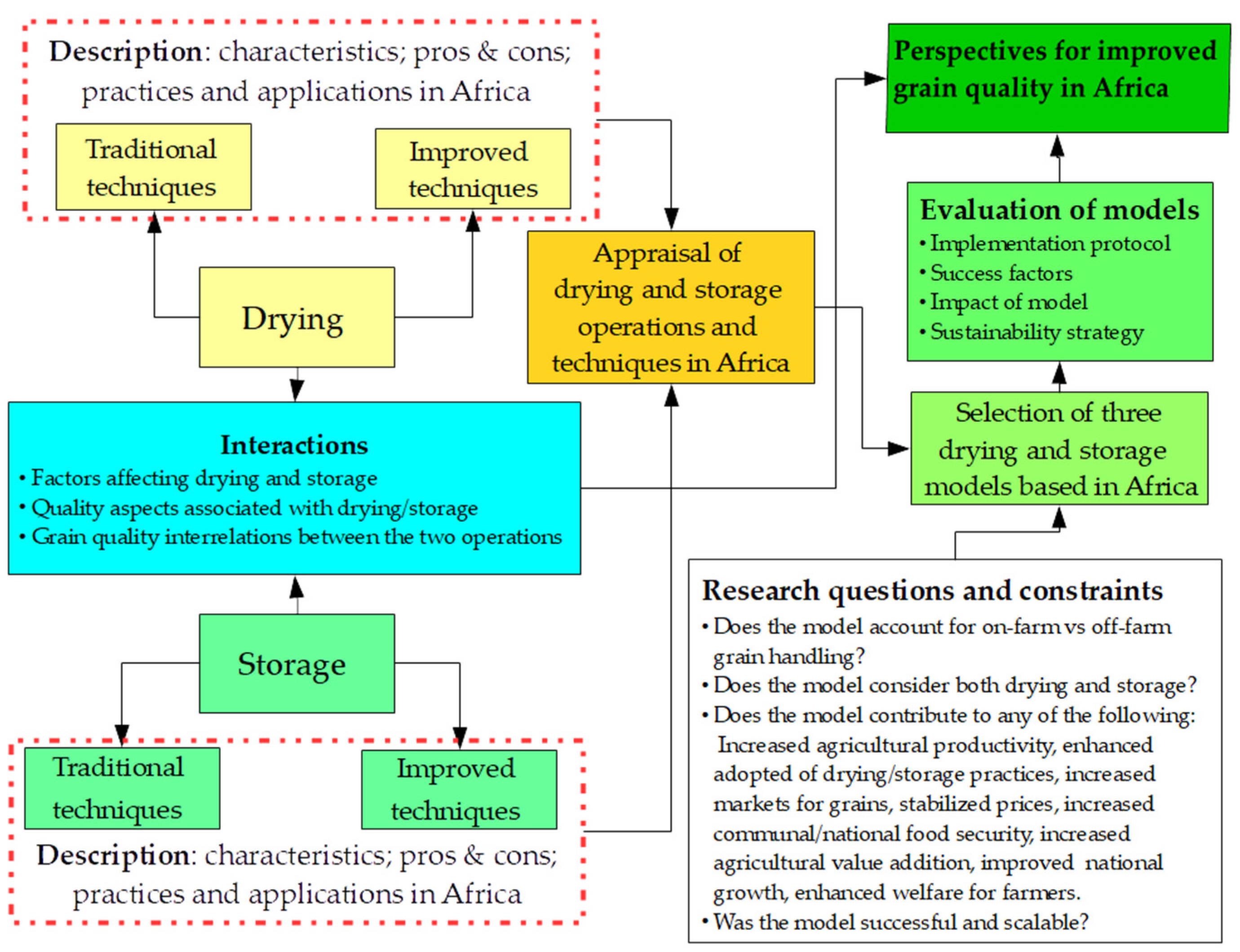


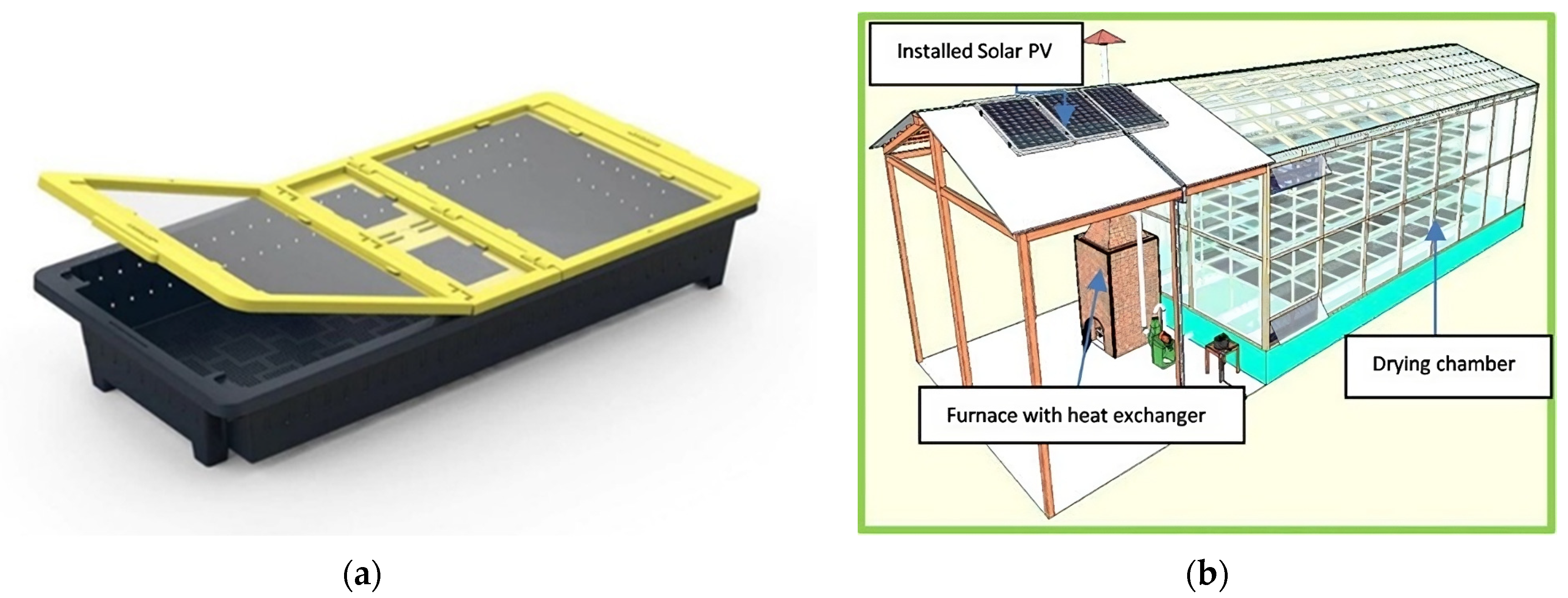


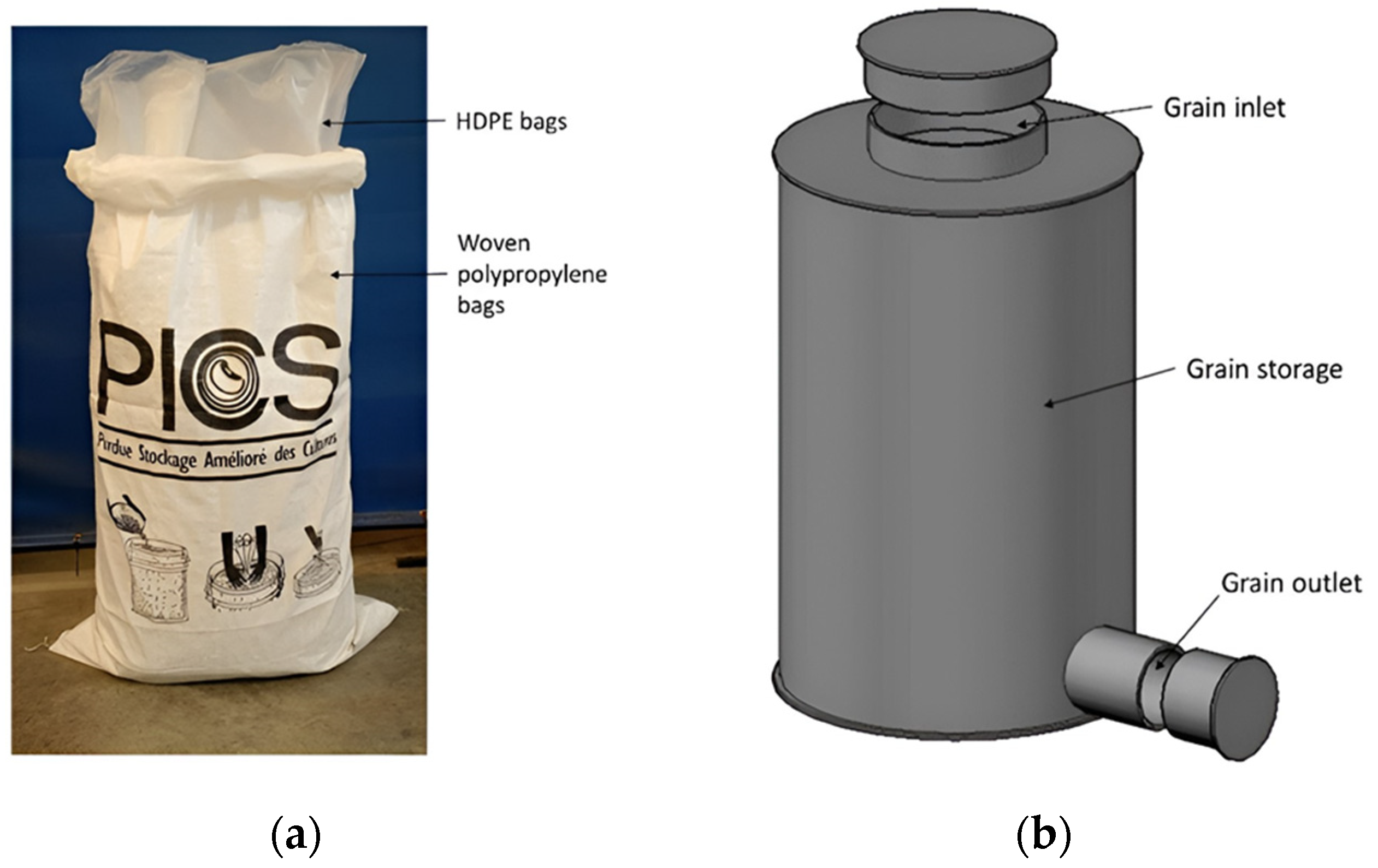

| Drying Technology | Characteristic Features and Functionality | Classification | Pictorial |
|---|---|---|---|
| Direct solar dryers [61,73,74] | The drying chamber consists of drying trays enclosed in a transparent cover made of polyethene with air ducts to maintain air circulation in the system. Can be of box or greenhouse type depending on the production capacity. The air circulation can be due to natural convection (passive) or forced convection (active mode) | Direct passive solar dryer (greenhouse type) | 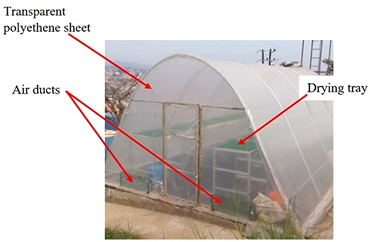 |
| Direct active solar dryer (greenhouse type) | 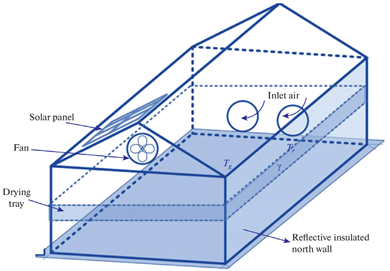 | ||
| Indirect solar dryers [75,76] | Composed of three critical parts—the solar collector, drying unit, and an air duct for circulation. The drying chamber is embedded with drying trays on which grains are placed and a chimney to allow the humid air to exit. The air ducts transport hot air into the drying chamber and over/through the drying trays after first passing through a low-pressure drop solar collector. The solar collector is normally inclined for maximum solar absorption. Can operate at higher drying temperatures, thus facilitating deep layer drying | Indirect passive solar dryer |  |
| Indirect active solar dryer | 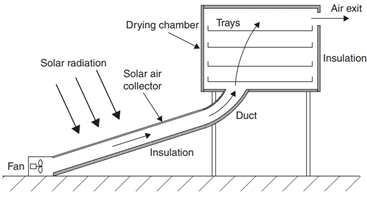 | ||
| Mixed mode solar dryers [76,77] | Consists of the solar collector, drying unit, and an air duct for circulation. The drying unit consists of drying trays enclosed in a transparent cover made of polyethene. The air ducts maintain air circulation in the system. Collects solar radiation from the drying chamber and the solar collector, which are features specific to the direct and indirect solar dryers, respectively. Can be in the form of passive (without fans) and active dryers (with fans) | Active mixed mode solar drier | 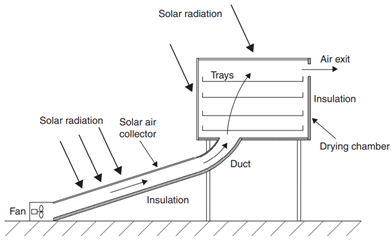 |
| Passive mixed mode solar drier |  |
Disclaimer/Publisher’s Note: The statements, opinions and data contained in all publications are solely those of the individual author(s) and contributor(s) and not of MDPI and/or the editor(s). MDPI and/or the editor(s) disclaim responsibility for any injury to people or property resulting from any ideas, methods, instructions or products referred to in the content. |
© 2024 by the authors. Licensee MDPI, Basel, Switzerland. This article is an open access article distributed under the terms and conditions of the Creative Commons Attribution (CC BY) license (https://creativecommons.org/licenses/by/4.0/).
Share and Cite
Baidhe, E.; Clementson, C.L.; Senyah, J.; Hammed, A. Appraisal of Post-Harvest Drying and Storage Operations in Africa: Perspectives on Enhancing Grain Quality. AgriEngineering 2024, 6, 3030-3057. https://doi.org/10.3390/agriengineering6030174
Baidhe E, Clementson CL, Senyah J, Hammed A. Appraisal of Post-Harvest Drying and Storage Operations in Africa: Perspectives on Enhancing Grain Quality. AgriEngineering. 2024; 6(3):3030-3057. https://doi.org/10.3390/agriengineering6030174
Chicago/Turabian StyleBaidhe, Emmanuel, Clairmont L. Clementson, Judith Senyah, and Ademola Hammed. 2024. "Appraisal of Post-Harvest Drying and Storage Operations in Africa: Perspectives on Enhancing Grain Quality" AgriEngineering 6, no. 3: 3030-3057. https://doi.org/10.3390/agriengineering6030174







